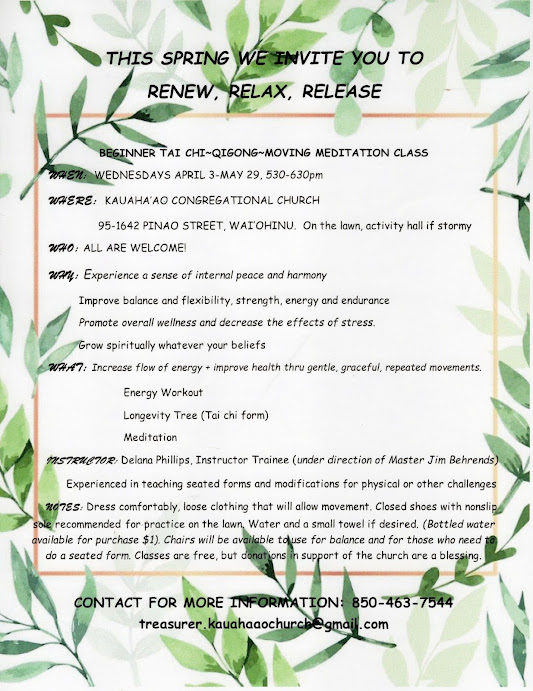 |
| Akiapōlā‘au (Hemignathus munroi) is one of the rarest birds in the Kaʻū forests. Photo from National Park Service |
In addition to being the coastal conservation leader in all of Hawai‘i, Kaʻū is the forest conservation leader in the Hawaiian Islands. The state's Kaʻū Forest Reserve is 61,000 acres. Its Kapāpala Forest Reserve is 37,276 acres. The Nature Conservancy Kaʻū Preserve consists of four separate areas totaling 3,548 acres that enable management access to state forest reserve lands. Kamehameha Schools holds about 67,357 acres in Kaʻū, planted acres of koa trees above Pāhala and hosts a captive breeding facility for the endangered Hawaiian crow on its property at Volcano.
Hawai'i Volcanoes National Park acquired 116,00 acres stretching from Kahuku above South Point through lands above Nā‘ālehu, Pāhala and the state forest Forest Reserves to Volcano. Most of Hawai‘i Volcanoes National Park is in Kaʻū, all the way to Halema‘uma‘u Crater. Residents in Volcano have protected the trees on their lands to provide a flyway for birds.
Hawaiian Homelands in Kaʻū total 11,312 acres, including native dry and wetland forests. The county, nonprofits and private owners have preserved forest land for conservation. Resource managers from government and nonprofits, as well as private landowners help protect the native birds. Among the rarest are ‘Akiapōlā‘au (Hemignathus munroi), Hawai‘i Creeper (Oreomystis mana) and Hawai‘i ‘Akepa (Loxops coccineus).
 |
| A portion of the native forests and habitats of Hawaiian native birds in Kaʻū. Map from DLNR |
A statement from the Mayor's office says:
"For millions of years prior to human contact, Hawaiʻi’s forests were the dominion of our native nā manu nahele (forest birds), comprising at least 84 species including honeycreepers, honeyeaters, flycatchers, thrushes, warblers, hawks, owls, and crows. Nā manu nahele have critical ecological roles in Hawaiʻi as pollinators, seed dispersers, and insect managers in our Hawaiian forests, sometimes so closely co-evolved with plant species that native plants cannot reproduce without them.
"The threats to the remaining manu species, particularly honeycreepers, include habitat loss; habitat degradation by invasive plants, insects, and diseases; predation by invasive rats, cats, and mongoose; and deadly diseases spread by mosquitoes, particularly avian malaria.
"Nā manu nahele are an inextricable part of Native Hawaiian culture in their roles as ʻaumakua (family deities) and messengers between akua (gods) and kānaka (people). Nā manu nahele are celebrated in mele (songs) moʻolelo (stories), ʻōlelo noʻeau (proverbs), kaʻao (legends), and in the creation of feather adornments.
'Hawai‘i is experiencing a bird extinction crisis, with roughly two-thirds of its known native manu nahele species having become extinct. Nearly all of the remaining 26 species are facing critical threats.
“'Protecting our natural and cultural resources is at the core of our vision for a sustainable Hawaiʻi Island where our keiki can raise their keiki for generations to come,' said Mayor Mitch Roth. 'We are proud to declare this year the year of the forest birds, honoring all those who dedicate their careers to the restoration and conservation of our native forests so that the many creatures, including our endemic birds, can thrive and continue calling Hawaiʻi Island home.'
"Continued community awareness and active support for native forest stewardship are essential to mālama native nā manu nahele as part of the Hawaiʻi ʻohana," concluded the statement from the Mayor's office.
To read comments, add your own, and like this story, see facebook.com/kaucalendar. See latest events, print edition and archive at kaunews.com. See 7,500 copies the mail and on stands.
 |
| ‘Alala is extinct in the wild but raised in captivity in Ka‘ū near Volcano to be released into the native forest. Bret Mossman Photo from DLNR |
WILMA RODDY, OF NĀ‘ĀLEHU ELEMENTARY, IS ONE OF THE TOP 15 PRINCIPALS IN HAWAI‘I'S PUBLIC SCHOOLS, according to sponsors of the 2024 Masayuki Tokioka Excellence in School Leadership Award. State Department of Education and Island Insurance Foundation honored them on Saturday in Honolulu, where each received $1,000 as finalists.
The top 2024 Masayuki Tokioka Excellence in School Leadership Award recipient and two semi-finalists will be announced during the official program at the Public Schools of Hawai‘i Foundation annual dinner on Thursday, April 18.
At the gala fundraiser, the Masayuki Tokioka Excellence in School Leadership Award winner will receive $25,000: a $10,000 personal award and $15,000 toward a school project of the principal’s choice. Two semi-finalists will each receive a $2,000 cash award.
Other principals in the finals from Hawai‘i Island are Hanana Loyola of Kohala Elementary School and Tiffany Pratt of Kaʻūmana Elementary School.
The award is named for the late Masayuki Tokioka, founder of Island Insurance Company, Ltd. and a graduate of Hawai‘i public schools. It was established in 2004 and is underwritten by the Island Insurance Foundation.
Last year, Pāhala High & Elementary School Principal Sharon Beck won the statewide honor and $25,000 award.
At the gala fundraiser, the Masayuki Tokioka Excellence in School Leadership Award winner will receive $25,000: a $10,000 personal award and $15,000 toward a school project of the principal’s choice. Two semi-finalists will each receive a $2,000 cash award.
Other principals in the finals from Hawai‘i Island are Hanana Loyola of Kohala Elementary School and Tiffany Pratt of Kaʻūmana Elementary School.
The award is named for the late Masayuki Tokioka, founder of Island Insurance Company, Ltd. and a graduate of Hawai‘i public schools. It was established in 2004 and is underwritten by the Island Insurance Foundation.
Last year, Pāhala High & Elementary School Principal Sharon Beck won the statewide honor and $25,000 award.
To read comments, add your own, and like this story, see facebook.com/kaucalendar. See latest events, print edition and archive at kaunews.com. See 7,500 copies the mail and on stands.
See presentations on https://www.youtube.com/@malamakai










.heic)
